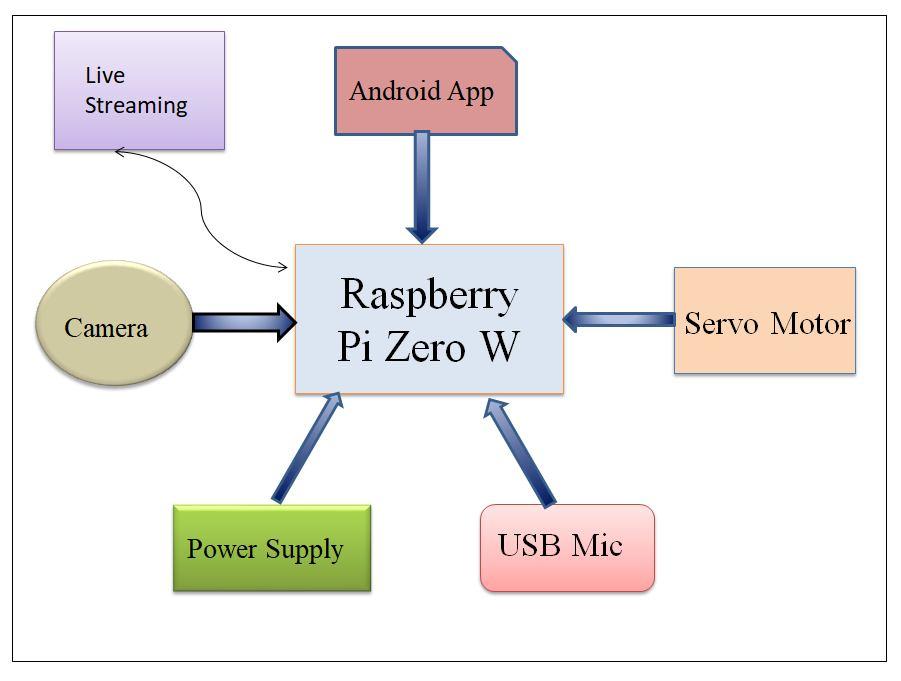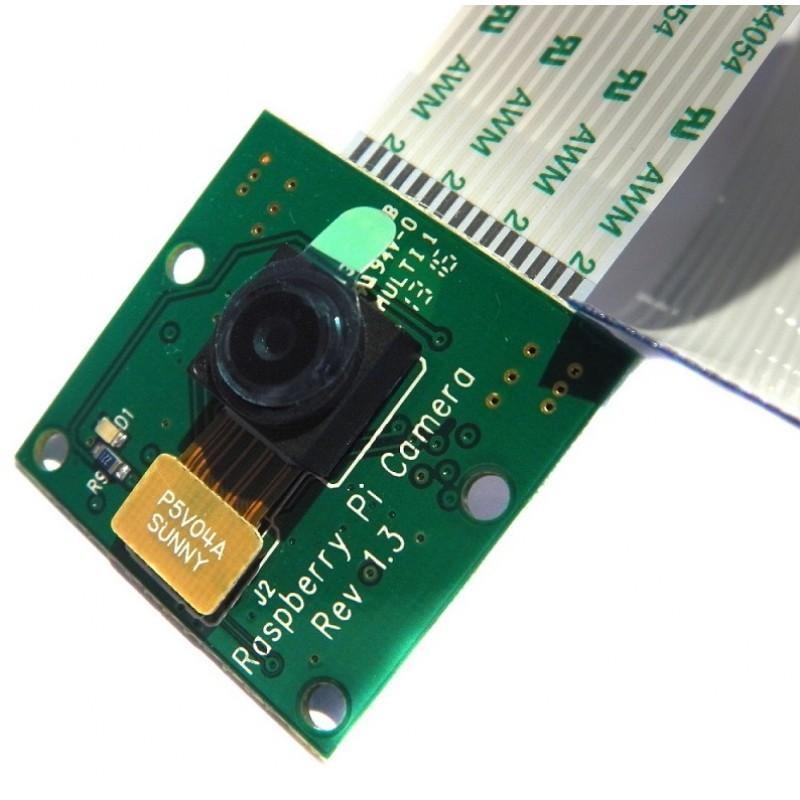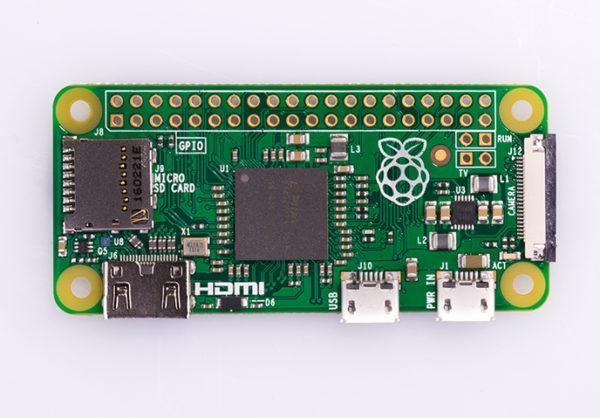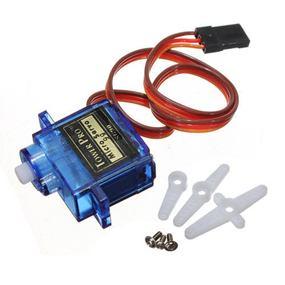

Web and Speech Controlled Video Surviellance Robot
Abstract: Video surveillance can be defined as the process of monitoring a circumstance, a human or a place. Human surveillance is obtained by posting people near sensitive places in order to constantly detect the changes. But we have many restrictions like we cannot go to dark, narrow and remote places and work efficiently and deployment in inaccessible places is not possible.
In this paper, we are going to develop a robot which can be used to perform monitoring and surveillance and this can be controlled through web applications and local speech. This robot is mainly used to watch live video surveillance and streaming footage which can be viewed remotely through a web browser. The spider robot can be run using two methods, firstly is through voice commands and the other is from the web interface. These commands cover both recognition and ‘intent detection’.
Keywords: spider robot, web and speech-controlled robot, raspberry pi.
I. INTRODUCTION

Nowadays robots are widely used in a lot of commercial applications for various activities such as painting, pick and place, assembling of subsystems and also in hazardous places for material handling and other things. Nowadays as technology advances in the areas of CPU speed, sensors, memories etc the robots are becoming more and more intelligent. And we can find many applications even in the field of defence. With the rapid growth of the Internet, more and more intelligent devices have been embedded into the robot for security, service and entertainment, including telescopes, distributed computer systems, surveillance cameras, manipulators, and mobile robots. Except for operating in hazardous environments that are traditional Telerobotic areas, Internet robotics has opened up a completely new range of real world applications like automated video surveillance. Surveillance is nothing but to watch from a distance, while surveillance robots can be used for monitoring the activities, behaviour, and other changing information which is gathered for the general purpose of managing, protecting or directing one's assets or position. Surveillance cameras are used to monitor public and private spaces. The future is likely to place a lot of importance on security. So, robots may well be performing dangerous jobs normally done by the police, and automated incident detection cameras will be used to enable fast intervention by security personnel.
Using video surveillance one can easily observe or analyse a particular area for business and safety purposes. Video surveillance cameras have turned popular owing to the ease that they offer when it comes to security surveillance. Also, for the growing population, video surveillance in household environments has become a very important aspect. In our project, we have built a robot that uses surveillance to detect abnormal events by using audio and video information. Here, the main aim is to use a camera which provides continuous coverage of the site in all directions where our robot moves. This machine is a unique blend of hardware and software. This is a mobile platform which a person can control through his computer with proper feedback through a webcam. This is a web and speech controlled surveillance spider robot. Users can control the robot using two ways, firstly by a web controlled interface and secondly by giving it voice commands. So, whenever we call it by its name, it takes our voice command as input, and then according to the input commands it will move in different directions. Then, we will use intent detection method. Using this method, the same command will be given in different ways. Coming to the web part, one can simply open a URL in any browser and will be able to control the spider. The developed web page consists of all the buttons from where the user can control the movement of the robot. Similarly, with the help of the robot's camera the user can watch the live video by opening another URL in the web browser.
The main purpose behind our project is to perform surveillance of large areas where humans could not complete the work efficiently or narrow areas. For example, in tunnel areas, dangerous places for people, dark and small places, security purposes, tracking and many other things.
Dr. Ravindra S1, Priyanka2, Roja S N3, Shreya Prasanna Torke4 , Raghupathi V5 Department of Electronics and Communication, Dayananda Sagar College of Engineering, Bangalore,
(IJRASET
ISSN: 2321 9653; IC Value: 45.98; SJ Impact Factor: 7.538 Volume 10 Issue IX Sep 2022 Available at www.ijraset.com

During natural disasters, it is difficult to find survivors. These disasters can range from hurricanes to wildfires to mass violence and affect humans directly as well as through exposure to media coverage of the incident. India is highly exposed to natural disasters, because of its geographical position and intertropical convergence. India also faces periodic atmospheric phenomena. How can we use technology to find survivors during disasters by a secure method? The objectives of the project are
1) Developing a spider robot that is used for surveilling through a camera and also uses mic to recognize the speech.
2) Build a robot which can move in different directions.
3) Control the movements of the robot through web applications and local speech.
II. LITERATURESURVEY
1) “Design and Implementation of Speech Controlled Spider Bot” by Hafezur Rahman Chowdhury, Kazi Mu stafizul Gani, Tauhid, Sakil Khan, Saniat Rahman Zishan and Wayes Arefin, in 2017. This paper contains the development of hardware & software of spider bot. The robot consists of four legs that will move in all the directions given by the user. One of the advantages of spider robots is that they are more skilled to move in harsh territory than other robots.
2) “Multitasking Spider Hexapod Robot” by Md. Arif Abdulla Samy, Md. Iqbal Hossain, Md. Shahriar Alamgir, Md. Imran Uddin. The robot which contains six mechanical legs for the movement is called a hexapod robot which is also a spider robot. This robot is more flexible than robots with wheels and it can travel in many difficult terrain areas. It is mainly designed to overcome many difficult problems which are considered hard and dangerous for humans to solve on their own.
3) “Web Controlled Surveillance Robot” by Shreyas Bhandari, Devjyothi Ghosh, Vedant Shirali, Shaarang Sahanie and Mudit Kapoor. This paper portrays a robot which is developed to go to risky places without considering its surrounding area and convey the information according to its surrounding environment to the user from the server. This robot utilizes a camcorder to view its surroundings. Also, the camera placed on the robot works as theeye and the remote control and server acts as the robot's brain as it controls it’s working.
4) “Surveillance Robot using Raspberry Pi and IoT” by Muhammad Hameem, Safwat Hussain and Harshitha R. In this paper they developed a robot which can be used in different households. Here, they have used Raspberry Pi 3 Model B as the base controller. A webcam is attached to the Raspberry Pi to monitor an area. And it will send a notification when it detects any trespassing or obtrusion.
III.METHODOLOGY

Science
Engineering Technology (IJRASET
ISSN: 2321 9653; IC Value: 45.98; SJ Impact Factor: 7.538

Volume 10 Issue IX Sep 2022 Available at www.ijraset.com
To monitor toxic environments a spider robotic system can be used. Basically, this robot can be controlled through web interface and speech. We call the robot with its a name and it will start listening and after that we can give it any kind of command like go forward or maybe turn on the light, turn on the camera and this is the speech control part and then there is the web control part where we are going to control this using a mobile phone with an TCP|UDP application, and then we will be able to control it. Then there is live surveillance so here there is a camera and we will be able to see whatever it is seeing from the camera. We use servo motors, batteries and Bluetooth to control the robot. For speech recognition we use a raspberry pi which is decoded in python. We then connect all the components to the raspberry pi . Codes for controlling the servos will be inside the Raspberry Pi and it will take the voice commands and use these commands to control the servo motors.. We can use a five volt supply and that will be enough for the raspberry pi.
We use pico voice for speech control. For the camera we use raspberry pi zero camera. To view the live video, we can use RPi Cam Web Interface. We use two lithium ion batteries through which we get around seven to eight volts.
Then we use a buck converter which converts these seven to eight volts five volts. Then those five volts is given to the Raspberry Pi. We need Bluetooth to connect the mic. The spider robot acts as a perfect solution to these problems, removing the demand for humans to access dangerous places and regularly providing information which is otherwise not accessible by humans.
IV.TOOLS
These are the components we have used to build this model:
1) Raspberry Pi Zero W
2)
Pi camera
Ion Battery
Mini Servo
pieces
pieces
a
monitor, which is then connected to the internet.
OS differs as there are many distributions in its
page
nowadays almost every user is based on Linux systems. The Raspberry Pi is a famous SBC (Single Board Computer) and in that it is a complete system packed into a single board. Many are familiar with the Raspberry Pi 3 and its previous versions, whose features can be identifiable by the users. It can also be used in even smaller projects.
B. Raspberry Pi Camera
Raspberry Pi Zero W and Raspberry Pi Zero Version 1.3 are supported by Raspberry Pi Camera. It has 5 megapixel OV5647 sensors. This is the newest version of the Raspbian OS, making it suitable for recording video, photography, security applications and movement identification. Connect the cable to the CSI (Camera Serial Interface) port which is on Raspberry Pi. The dimension of the board is around 25mm x 23mm. The specifications of the camera include charged coupled device length is 0.25 inch, aperture is 2.8 and focal length is 3.21mm. It has a picture resolution of 2592x1944. Supports video qualities like 1080p30, 720p60, and 640x480p60/90.


size 25x24x9 mm
Weight 3 g Still Resolution 5 Megapixels Video modes 1080p30, 720p60 and 640x480p60/90
Sensor Omni Vision OV5647 Pixel size 1.4 mx1.4m S/N Ratio 36dB
Table

ISSN: 2321 9653; IC Value: 45.98; SJ Impact Factor: 7.538 Volume 10 Issue IX Sep 2022 Available at www.ijraset.com

C. Servo Motors

A Servo motor is used to achieve rotational motion and it gives exact angle of rotation, speed, and acceleration. The servo motors are widely used in different places like home automation, toys, vehicles, etc. We can see the application of servo motors in our day to day lives. Electronic devices such as Blu ray disc PWMTM and DVD players use servos to extend or retract the disc trays.
Torque 2.0 kg/cm(~4.8V), 2.2 kg/cm(~6V)
Speed 0.09s/60°(~4.8V), 0.08s/60°(~6V)
Rotate angle 180°
Operating voltage 4.8 6 Volts
Weight 10.5grams Dimension 22.8mm × 12.2mm × 28.5mm
Table 3: servo motor specifications
Servo Motor V. IMPLEMENTATION
A. Hardware Implementation
Firstly, we need to attach all the servos to Raspberry Pi and then the numbering is given to each servo motor. Next, the Raspberry Pi sketch is uploaded. After that, we should make sure that all the main movements like backward, forward, right, left etc are working or not. Next, the camera, mic and are connected to Raspberry Pi. In the next step, we have to make sure that the Raspberry Pi camera and USB mic which are connected to the Raspberry Pi are working according to our requirements or not.
B. Software Implementation
Here we use TCP/UDP application to control the movement. For the live video streaming, we must use RPi Cam Web Interface, due to the fact that the latency is very low here. And for the speech recognition and hot word detection part we can use Pico voice and we can modify the code in python.
International Journal for
in
Science & Engineering Technology (IJRASET)

ISSN: 2321 9653; IC Value: 45.98; SJ Impact Factor: 7.538
Volume 10 Issue IX Sep 2022 Available at www.ijraset.com
VI.RESULTS&DISCUSSIONS
Here we get two results i.e., one is hardware and another is software. The hardware part contains the robot model which runs on the Servo motors. The input to the motors is given using two ways, one is through the web page and other is through speech. On receiving the signal, the board will process it and then generate the appropriate output
1) This spider robot can walk like a spider and do surveillance through its camera.
2) It can perform good surveillance of the area including both audio and video using Arduino and raspberry pi.
3) The robot can be controlled using web applications and speech.
VII. CONCLUSION
The spider robot is implemented to provide a suitable range of simplicity and efficiency delivering every user with a smooth user experience. The main aim of our spider robot is to provide surveillance of the required environment. This robot can also be personalized so that it can be used in any godowns, storehouses or apartments. Based on standard and completely expandable designs, the robot can be implemented to be upgradable and allow for future control extensions, thus improving the usage for the user and to provide an effective way than the traditional surveillance system.
REFERENCES
[1] Kazi Mustafizul Gani, Hafezur Rahman Chowdhury, Sakil Khan and Tauhid, “Design and Implementation of Speech Controlled Spider Bot”, Department of EEE, American International University Bangladesh, Dhaka, Bangladesh, ISSN: 2394 658X, 2017.
[2] Md. Imran Uddin, Md. Shahriar Alamgir, Md. Iqbal Hossain, Md. Arif Abdulla Samy, “Multitasking Spider Hexapod Robot”, Dhaka, Bangladesh, Electronic ISBN:978 1 7281 5852 5, USB ISBN:1 7281 5851 8, Pod ISBN:978 1 7281 5853 2, DOI:10.1109/RAAICON48939.2019.58, 29 Nov. 1 Dec. 2019.
[3] Devjyoti Ghosh, Shaarang Sahanie , Shreyas Bhandari , Vedant Shirali , Mudit Kapoor, “Web Controlled Surveillance Robot”, IEEE, Mumbai, Maharashtra, India, ISSN 2250 2459,Volume 5, Issue 10, October 2015.
[4] Harshitha R and Muhammad Hameem Safwat Hussain, “Surveillance Robot using Raspberry Pi and IoT”, IEEE, Bangalore, India, Electronic ISBN:978 1 5386 7523 6, Print on Demand (PoD):978 1 5386 7524 3, DOI:10.1109/ICDI3C.2018.00018, 25 28 April 2018.
[5] Megmet Cavas, Muhammad Ahmad Baballe,” A REVIEW ON SPIDER ROBOTIC SYSTEM”, ISSN:2220 9085(Online)ISSN:2412 3587 (Print), DOI:10.17781/P002604, 2019.
[6] V. Shivaraju and V. Karthik Kumar, “Robot Controlled Car using Wi Fi Module”, IJSETR, India, ISSN 2319 8885 Vol.06, Issue.04, Pages:0759 0762, February 2017.
[7] Thair Ali Salh and Mustafa Zuhaer Nayef, “Intelligent Surveillance Robot”, IEEE, Mosul, Iraq, Electronic ISBN: 978 1 4799 5633 3, DVD ISBN: 978 1 4799 5632 6, DOI 10.1109/ICECCPCE.2013.6998745, 17 18 December 2013.
[8] S. Rooban, C. Joshitha, Idupulapayi Venkata Sai Eshwar and Mary Swarna Latha Gade, “Surveillance and Obstacle Avoiding Autonomous Robot”, IEEE, Pune, India, Electronic ISBN: 978 1 7281 8402 9, DOI 10.1109/ASIANCON51346.2021.9544623, 27 29 August 2021.
[9] Asha Rashmi Nayak, Saishree CS Ayyar, O Aishwarya, Mahitha CH and N. Mohankumar, “Security Surveillance Bot for Remote Observation During pandemics”, IEEE, Coimbatore, India, Electronic ISBN: 978 1 7281 5371 1, DOI 10.1109/ICCES48766.2020.9137935, 10 July 2020.
[10] H. M. Gross, H, J Boehme, T. Wilhelm, “Contribution to vision based localization, tracking and navigation methods for an interactive mobile service robot”, IEEE, Tucson, AZ, USA, Print ISSN: 1062 922X, DOI 10.1109/ICSMC.2001.972991, 06 August 2002.
[11] https://create.arduino.cc/projecthub/diyguyChris/arduino spider robot quadruped 57b832
[12] https://www.electronicshub.org/quadruped robot using arduino/

